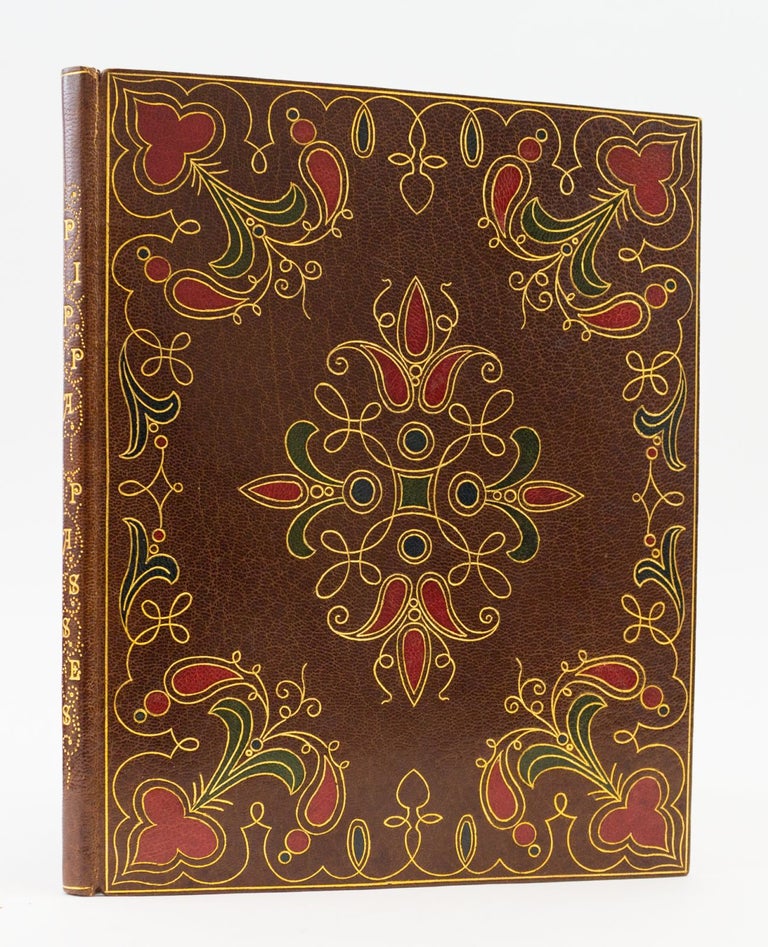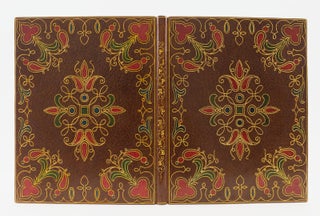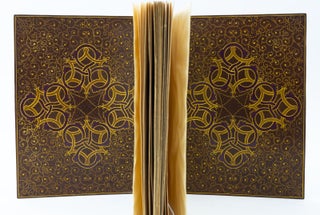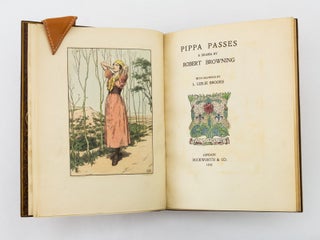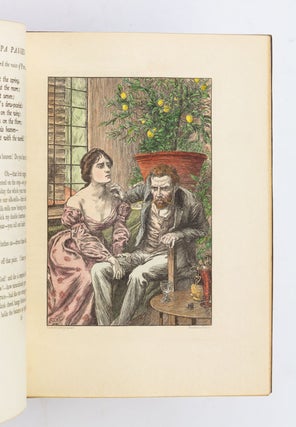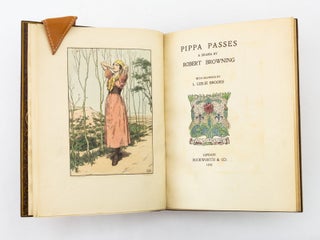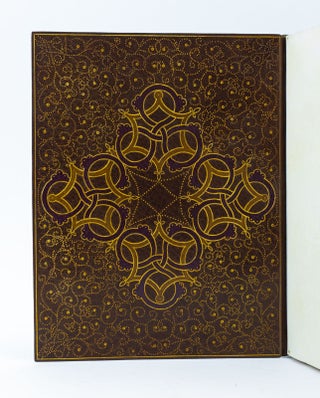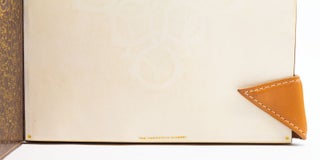PIPPA PASSES.
(London: Duckworth & Co., 1898). 228 x 175 mm. (9 x 6 7/8"). 4 p.l., 63, [1] pp. No. 21 OF 60 COPIES on Japanese vellum, 50 of which were for sale.
SUPERB BROWN CRUSHED MOROCCO, EXUBERANTLY GILT AND INLAID, BY THE HAMPSTEAD BINDERY (stamp-signed on front free endleaf), covers with central lozenge of inlaid stylized red and green morocco lilies, connected by delicate, gilt calligraphic flourishes, this enclosed by a frame of similar inlaid botanical shapes and gilt tooling, smooth spine with vertical offset gilt lettering intertwined with dotted gilt vine, ELABORATELY GILT BROWN MOROCCO DOUBLURES inlaid with a strapwork lozenge formed by purple morocco knots and citron morocco hexagons, all on a background with myriad stippled gilt vines terminating in gilt circlets, vellum endleaves, top edge gilt. In a green buckram drop-back box lined with fleece. With printer's device on title page, strapwork ornament on final page, and seven hand-colored plates by Leslie L. Brooke. Printed on Japon. See Day, "History of English Literature, 1837 to the Present," pp. 32-33. ◆The two free endpapers somewhat wavy, otherwise A VERY FINE COPY OF A BEAUTIFUL BOOK, immaculate internally and in a lustrous, unworn binding.
This handsome edition of Browning's poetic drama comes in an opulent binding by Frank Karslake's Hampstead Bindery, where a number of members of the Guild of Women Binders received their training. Karslake opened the bindery near his Charing Cross Road bookshop in January of 1898, with Alfred de Sauty as chief designer; P. A. Savoldelli, Thomas E. Carey, and Thomas Harrison as finishers; Samuel Tout and Sylvester Byrnes as forwarders; and a Miss Rogers as the sewer. Our binding likely hails from the bindery's earliest days, when it employed arguably the most talented artisans who would ever work there. Karslake formed the Guild of Women Binders later in 1898, and often assigned the (male) professionals at the Hampstead workshop to execute the designs of the Guild's members. He also set up a workroom for the Guild at Hampstead, with training to be provided by the bindery staff, then issued catalogues and staged exhibitions featuring productions from both workshops. Workers at Hampstead began to go elsewhere, perhaps, as Tidcombe speculates, because they had been irritated to have the responsibility for training the women added to their duties, or were upset over having their own craftsmanship attributed to the Guild of Women Binders. By 1901, only Savoldelli remained from the original staff, and by 1902 even Karslake's son Harold had quit; the bindery soon closed. The design of the present binding is playful, fresh, and unexpected--and almost certainly the work of Alfred de Sauty (1870-1949), who began his career as a finisher for the esteemed Riviere firm. In addition to creating designs for the Hampstead Bindery, he taught at the London County Council School of Arts and Crafts. He later emigrated, becoming manager of the Extra Bindery at R. R. Donnelley Co. in Chicago, where he became known as one of the most accomplished binders at work in the first third of the 20th century. As suggested by the present example, he had a refined imagination for design, in addition to being a binder of enormous technical skill.
The animated binding is an appropriate covering for Browning's uplifting drama, in which the lyric poetry sung by the good and innocent title character transfigures the worldly opportunists who overhear it. Pippa lives by the credo that made the work famous: "God's in his heaven / All's right with the world!" But, as DNB points out, "all is emphatically not right in the world of 'Pippa Passes,' and the overheard lyric acts as a commentary on the auditors' situations, and acts on the characters to great effect, causing significant changes in their viewpoints and actions. In working out the implications of this mode of poetic utterance Browning showed that the poet has a dialogic relationship with the audience and a responsibility from which he or she cannot escape. In effect, in the four scenes Browning shows how poetry is theatre, or performance, before an interactive audience." In Day's opinion, "Pippa" expresses one of Browning's essential beliefs: "The souls of men are mutually interdependent, and the simple goodness of the most naïve may have profound repercussions in transforming the lives of others to virtue." This attractively printed limited edition, in its lively binding, does seem to offer evidence that all is right with the (bibliophilic) world. (ST18606b)
Price: $9,500.00

